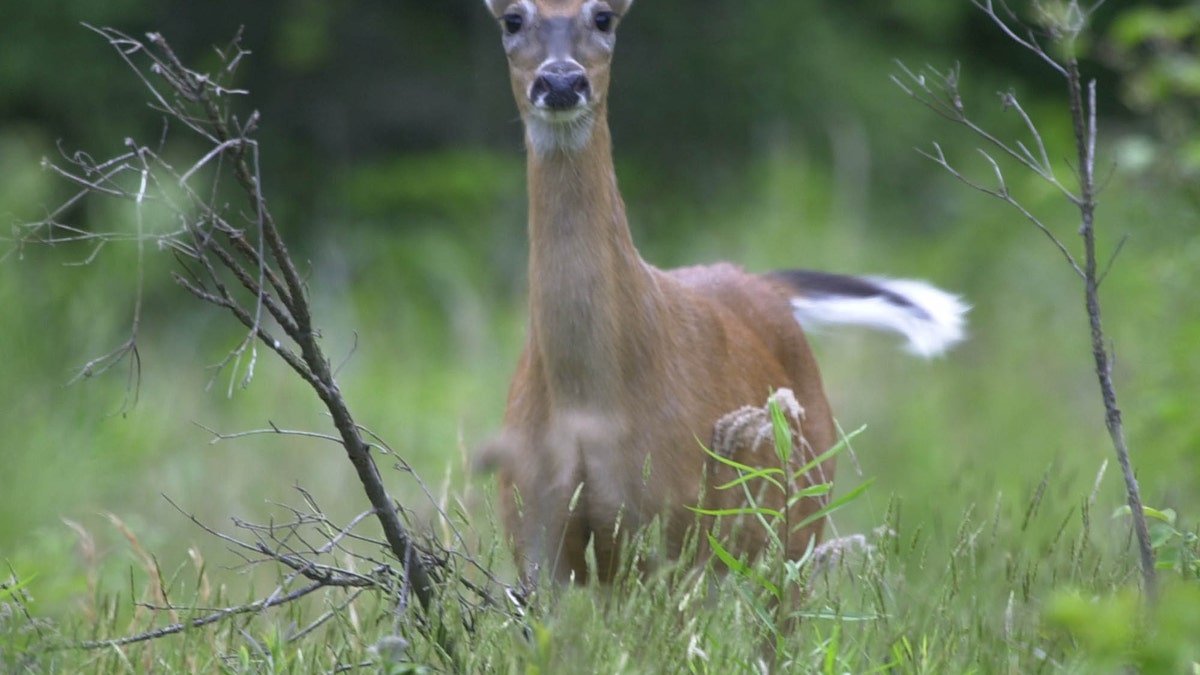
May 27, 2003: In a file photo, a White tailed deer flicks its tail as it stands alert while grazing in a field in Zelienople, Pa. (AP)
CHARLOTTE, N.C. – The sprawling Eastern Band of Cherokee Indian reservation in the western part of North Carolina has been trying for years to bring back a cultural symbol: White-tailed deer.
Now the tribe is partnering with state wildlife agencies in a long-term project it hopes will replenish the deer population on the 56,000-acre reservation.
Over the next three years, between 25 and 50 white-tailed deer -- mostly females in small family groups -- will be relocated from Morrow Mountain State Park to the reservation, known as the Qualla Boundary.
The Cherokees will place the animals in a special habitat improved for browsing and off-limits to hunting. The program will begin this month, with biologists using darts to tranquilize the animals, collecting data on age and health, and fitting each with a tag and a radio collar.
The deer will be kept in a large pen on the reservation and closely monitored for about four weeks before being released, said Charlie Peek, spokesman for the N.C. Division of Parks and Recreation, one of the agencies involved in the deer relocation project.
"They asked for our help, and this is a good way to do it," Peek said. He added that the Cherokees are paying for the cost of the project.
Cherokee Principal Chief Michell Hicks praised the project, saying its part of his administration's efforts to protect natural resources and restore native species.
"These efforts will have lasting effects on our tribal community and on the region," he said.
This isn't the first time Native Americans have tried to reintroduce culturally significant animals to a reservation. Several Great Plains tribes have sought to reintroduce bison to tribal lands. Bison were plentiful on the Great Plains until the early 1800s. But by the middle part of the century, they were nearly wiped out due to widespread slaughter by white settlers during westward expansion.
White-tailed deer figure prominently in Cherokee lore and cultural traditions, illustrated by the existence of the Cherokee Deer Clan -- Anikawi -- whose members were known as fast runners and served as both hunters and messengers. The animal was once considered the tribe's most important staple food source, and was essential to traditional clothing, arts, tools and stories. But like the bison, the deer population was nearly wiped out by white settlers.
Now there's only a sparse population of white-tailed deer on the reservation.
But the reason has to do with habitat, said Brad Howard, a private lands program coordinator at the N.C. Wildlife Resources Commission.
The Cherokee reservation is in the Blue Ridge Mountain range -- a picturesque area with fast-moving streams and deep forests. While the natural beauty is good for tourism, it doesn't always translate into a thriving deer population.
"Contrary to most people's perception, the forest is not actually the best deer habitat," Howard said. "People think that deer live in the woods. Well, truthfully, deer live on the edge of the woods, where there are fields and early stage vegetation. Deer need to have a lot of food at their height."
White-tailed deer will eat many green-leaved plants and fruits. One of their most important food sources: Acorns.
"If you look in the forest, there's not necessarily, other than the acorns that fall from the trees every fall, a lot of food at the deer's height compared to, let's say, in the fields," Howard said. "That's good deer habitat. That's where the deer are the most productive."
The Cherokees for the last few years have been trying to augment the reservations white-tailed deer population -- even suggesting bringing in deer from other states. But state wildlife officials said that wasn't a good idea, Howard said.
"This is a much better process. It's a more biologically sound process to use native white-tailed deer. That's the path we are on now," he said.
Still, it's going to take some time for the population to come back.
"It's a slow process. Just putting deer out won't get you what you need. You got to do that habitat work. You got to make available habitat for the deer and that's what they're doing," he said.




















